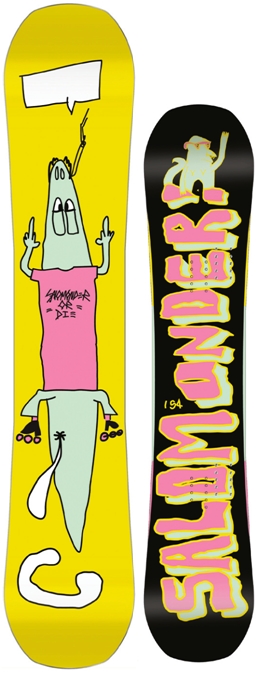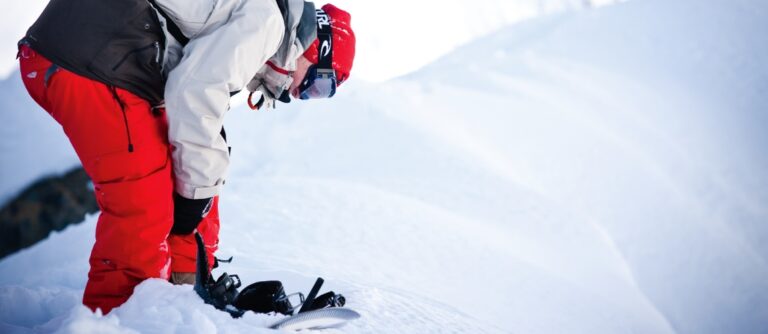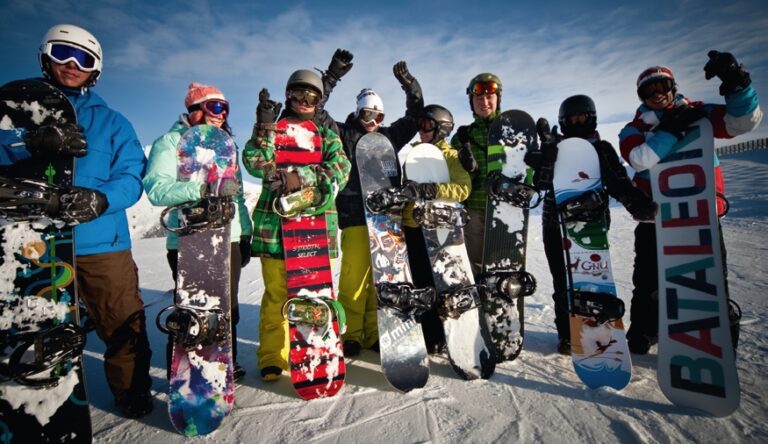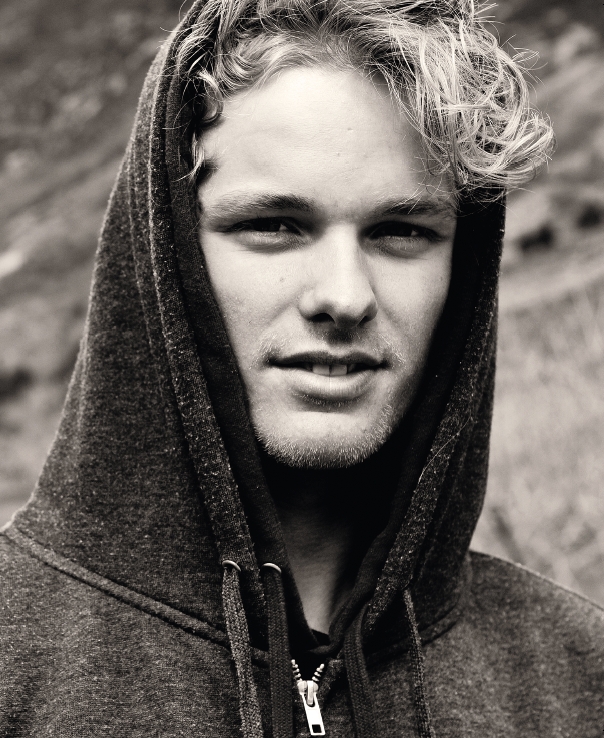Published in Whitelines Magazine Buyers Guide, Winter 2010-2011
Words & photos: Ed Blomfield
“ Greetings to you, the lucky finder of this Golden Ticket, from Mr Willy Wonka! I shake you warmly by the hand! Tremendous things are in store for you! Many wonderful surprises await you! For now, I do invite you to come to my factory and be my guest for one whole day – you and all others who are lucky enough to find my Golden Tickets. I, Willy Wonka, will conduct you around the factory myself showing you everything that there is to see…”
– ‘ What It Said on the Ticket’ Charlie and the Chocolate Factory
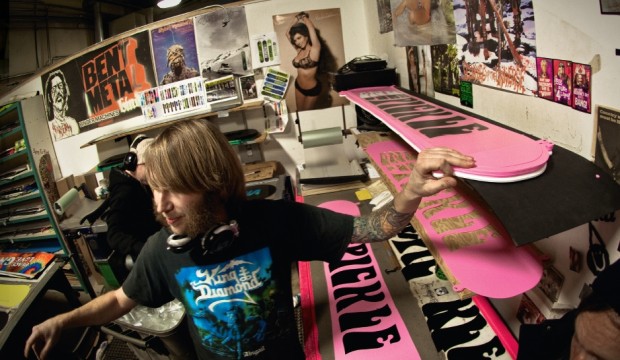
I might not have grown up as poor as Roald Dahl’s Charlie Bucket– the kid in who couldn’t even afford a chocolate bar – but when I first got into snowboarding the idea of buying my own shred stick was the stuff of fantasy. Back in the 90s, even basic snowboards were typically about 400 pounds – way out of the price range of a snotty teenager.
As anyone can tell you, though, the more unattainable something is, the more you want it. I would look at pictures of the latest pro models in the catalogue (in those days we were talking about the Burton Terje, Sims Noah Salasnek and the Lib Tech Jamie Lynn) and picture the tricks I would do on them. I often imagined how cool it would be to go to the factory where they were made. Snowboarding was taking the world by storm, and these fresh thinking brands – with their rapidly advancing technology and cool graphics – were at its heart. How amazing would it be to actually work at one of them, and get to try any board I liked?!
Since then I’ve been through more riding kit than most, but I was still buzzing like a kid when, last winter, I was invited to visit Mervin Manufacturing – the factory which produces Lib Tech and Gnu Snowboards. These guys are one of the oldest and most innovative outfits in the business, the dudes whose ‘Crazy Skate Banana’ inspired an industry-wide revolution in board design. I was going to be shown around the whole place, watch the latest line being made and, hopefully, learn a bit more about how the boards we all drool over start out in life. In short, I had a Golden Ticket!
And my guide for this journey of discovery? None other than Mike Olson, snowboarding’s answer to Willy Wonka. Olson, a shaggy-haired surfer from America’s Pacific Northwest, began experimenting with homemade snowboards as a teenager in1977, and by 1984 he had dropped out of college to pursue his hobby full time –establishing Mervin HQ in an old barn and paying the rent by mowing the lawn and cleaning the gutters for its owner. Together with his friend and business partner Pete Saari, he began selling boards to the growing snowboard community under the brand name ‘Gnu’. A design genius, Olson has developed countless innovations over the years, from side cuts to air-filled cores to Tefl on infused bases. Most famously, he is the brains behind two radical concepts: wavy edges (a.k.a. ‘Magne-Traction’)which work like a serrated knife to increase grip, and reverse camber (or ‘Banana Technology’) which reduces the likelihood of an edge-catch, improves buttering and increases float. Like Mr Wonka, Olson’s approach is downright eccentric, often looking to turn convention on its head – in the case of reverse camber, quite literally. And like Wonka, he even has his own ‘Inventing Room’ that is strictly off limits to visitors (“You see, all of my most secret inventions are cooking and simmering in here,” says Wonka in the book. “Old Slugworth would give his false teeth to get inside for just five minutes.” I couldn’t help wondering what Jake Burton would pay for a peek inside Olson’s private lab).
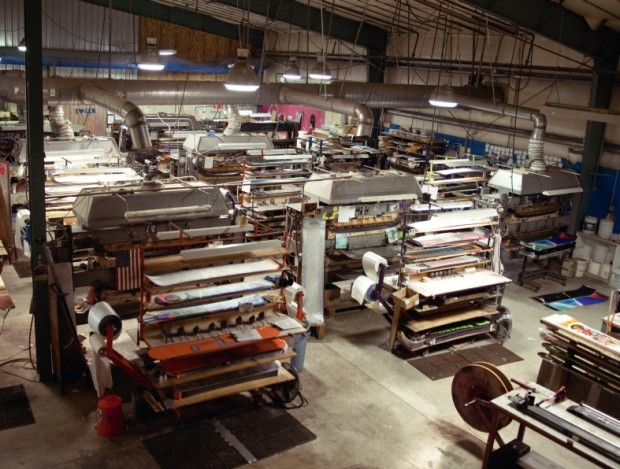
Our tour begins – where else? – at the gates to the Factory. A battered old car with a huge tree trunk on its roof marks the entrance – the same silver ST driven by Lib Tech rider Travis Rice in That’s It That’s All. It’s the first of many pieces of memorabilia we find scattered about the place: old adverts pinned to the walls, pieces of top sheet artwork draped over tables in the office, a starting hut from the legendary Mt Baker Banked Slalom parked under the trees outside. And of course, vintage boards are lurking in every corner– decorating rooms, lining staircases or serving as makeshift coffee trays.
Mervin HQ is located on a remote promontory near the border with Canada, a ferry ride and a two hour drive from Seattle. The nearest town, Port Angeles, has become a mecca for fans of the cult Twilight films, which are filmed in the woods nearby. It’s a quiet, spooky kind of place, popular with hippies and loaded with giant evergreens – the ideal spot to dream up new snowboards undisturbed.
The factory itself is divided into three main areas: offices, workshop and shipping. Having been whisked around the first – where we snatch a look at some curious binding designs amongst the clutter and even Peter Line’s CV (“he asked us for sponsorship when he was a kid but the team was full and we turned him down!” says Olson) we make our way over to a corrugated building which houses the factory floor. Here, a motley crew of workers assemble the snowboards while heavy metal pumps out of an old speaker. The staff are assigned jobs at different stages of production. In one area, a laser-guided blade slices out letters from a giant roll of p-tex, and a tattooed dude with impressive sideburns pieces them together to form a di-cut base design for the new Gnu Park Pickle. “I basically do jigsaw puzzles all day,” he explains. The centre of the workshop is filled with benches where another group of guys layer up the different parts of each board: Down goes the base, in go the edges, then res in and fiber glass, then the wood core, then more resin and fiber glass and finally the top sheet. It’s like building up a giant panini sandwich – which is then shoved in a hot press for about 20 minutes to seal it tight and imprint the rockered profile(‘Banana Technology’ isn’t exactly rocket science – essentially you just set up the bed of the press like a smile instead of a frown). Once cooked, the board passes on to a set of skilled machinists who saw off the excess material, finish the edges and feed it through a mangle-like waxing belt. A little bevel is added by hand to the edge of each topsheet, scraping a thin white line around the board. “Every guy gives it a different amount of bevel,” explains Olson. “I like this guy’s. Not too little, not too much.”He waves at him. “Good job dude!” Olson’s long-haired workers might not be Oompa Loompas, but every one of them rides and they all seem stoked on what they do – not surprising when perks include the chance to build a custom board every year.
Since 1997 Mervin has been owned by Quiksilver. Though the new owners wisely left Olson and his team to their own madcap devices, they did recently move production of their Roxy snowboards to this facility. In one corner I spot a punkish-looking girl hammering inserts into one of the Roxy boards, and again I am reminded of Mr Wonka’s twisted logic (“Little girl, whipped cream isn’t whipped cream at all unless it’s been whipped with whips. Everybody knows that.” Perhaps a woman’s board isn’t a woman’s board unless it’s made by a woman?)
Towers of different wood cores and brightly coloured sidewalls fill one whole end of the factory. Make no mistake, this is no longer a little garage operation. On the other hand it still has an organic, rider-owned feel to it. Fishing weights are adapted for use in the edge-gluing process; stickers adorn the heavy machinery and workstations are decorated with posters or torn out pages of hot girls. Meanwhile, up in the rafters, a giant billboard of 70’s TV icon Telly Savalas gazes down on proceedings like a benign Big Brother. “Mervin loves ya baby,” it says.

Olson explains that the whole factory is run on bio-diesel and certified green power; he and Saari make the fuel available to employees and local farmers under a co-op agreement. It’s part of their ‘Enviro MENTAL’ programme, which also sees them recycle all their wood off-cuts, replace toxic solvents with citrus-based ones and use a water-based sublimated graphics process. The boards are made with fast-growing, renewable farmed woods like bamboo and have begun employing top sheets made from ‘bio-plastic beans’ and, in some cases, basalt fibre (volcanic rock) instead of traditional fiber glass.
We don’t have time to dwell on all this information, however, because Olson is already embarking on another shaggy dog story. The man is a bottomless pit of information – part weird scientist, part snowboard historian. Like Wonka, he casually rattles off one surreal tale after another, leaving his breathless audience scratching their heads in wonder.
Example: I ask Olson where the Lib Tech logo came from – the funny little man with the evil grin and a pointy hat. “I was playing in the street with his friends one time when a kid comes up to us on a bike,” comes the reply. “The other guys ran off, and this kid grabs my arm and bites it. Like, real hard! I had teeth marks. That was the first time I met Paulie.” Olson explains that ‘Paulie’ had no friends, and that soon after his mum started making him go round once a week to hang out with him. Paulie would just sit there, watching an electric train go round and round the track for hours on end while Mike clock-watched. Paulie’s ambition, it transpired, was to be a fire truck. Mike created the now-familiar ‘Paulie’ smiley-face character in his school books (the ‘FD’ on his hat stands for ‘Fire Department’). Years later, Mike stuck this cartoon character on his boards for want of a better logo. Then, out of the blue, Paulie reappeared. He was all over the news. Turns out he had become the most prolific arsonist in the history of the world! “He set his first fire at eight,” Olson explains. “When he was older he went abroad and set fires across Austria and Europe. He caused more than 22 million dollars of damage and killed at least three people.”
”My mind is still reeling from this bizarre story when I ask him about Gnu. “How’d you come up with such a weird name?”
“I was really into wildebeest at the time,” recalls Olson, as if it’s the most natural explanation in the world. “I actually had a cat called ‘Wildebeest’. When I started making boards I went to an evening class on business and marketing. The guy leading the class said the best brand names were just a few letters long. That was too bad – I liked ‘Wildebeest’ but it didn’t really fit the rule, so I looked it up in the encyclopaedia and it said ‘see gnu’. I’d never even heard the word before!”
The tour finishes with a look at Olson’s new pet-project: surfboards. Having branched out into composite skate decks already (a technical success but still to win over many brand-loyal skaters) Mike has high hopes for his Lib Tech surf division. His enthusiasm is infectious. He doesn’t seem so motivated by the extra revenue stream, more the challenge of improving on traditional designs using his vast knowledge of materials. He demonstrates the durability of a nearly prototype by throwing it across the yard.“We’ve been testing them up the coast,” he says.“You see how it fl exes? This makes it bottom turn really well but it cuts back like crap!” He claims the answer to this performance problem lies with his latest model, which is safely under lock and key in the Inventing Room. The ultimate goal is aboard that requires less labour-intensive sanding, that boasts high performance, more strength and (thanks to the simplified build) bigger profit margins. If it actually works, it will revolutionise the market.
I leave Seattle with a renewed buzz for snowboard technology. Our sport was always supposed to be about free-thinking and creativity, but recently – what with the Olympics, corporate sponsorships and aggressive marketing – there have been more and more cries of ‘sell out’. This place proved that at the heart of the industry there are still some interesting characters who are driven by a curious mind and a love of the shred.
And while it might sound like I’ve fallen for Mervin’s charms, it’s worth pointing out that Olson and co are not the only guys flying the flag. Signal Snowboards (headed by former Mervin employee Dave Lee), Ride, K2 and the oft-criticised Burton all maintain factories in their hometowns, where they produce snowboards for sale across the world and/or spearhead their R&D. Each of these HQs is a very cool workplace with similarly passionate employees. But set-ups like these are not cheap, and when you look at the market as a whole, production has shifted towards bigger facilities in the Far East. From a business perspective, this makes total sense; boards made in China are not only cheaper (and therefore more affordable for kids) but almost indistinguishable in quality. As consumers, the question we have to ask ourselves is what we want from a snowboard beyond cool technology and sick graphics. My skint teenage self would be stoked on today’s low prices – back in the ‘90s I had to put up with rental gear for years. If you can afford it, though, it’s worth considering where your board has come from. Do you want Tesco Value or the full organic she bang? For me personally, if I could pay an extra10p for a chocolate bar that was mixed by waterfall, I probably would.


